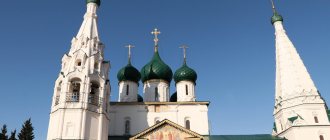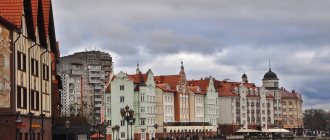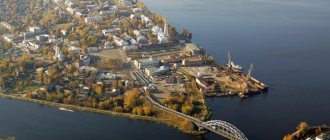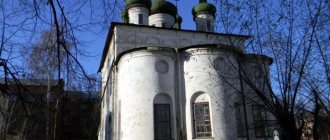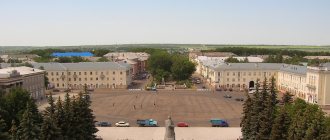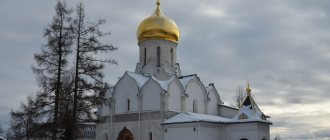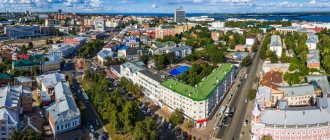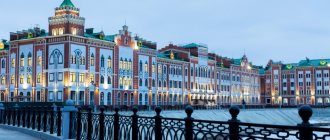Chistopol is a popular tourist town located on the left bank of the Kama River. The settlement is located 140 kilometers from Kazan. The compact merchant town is filled with a particularly atmospheric atmosphere, as its historical buildings have been preserved in excellent condition. Ancient mansions, small houses with carvings, and Orthodox churches are symbols of the city. The name of the city comes from the word “Clean Field”. The fact is that archaeologists discovered ancient Bulgar settlements on these lands.
There is information about the village in ancient chronicles of the 17th and 18th centuries. Serfs settled en masse in this area. Mostly these were people from among the fugitives. Subsequently, schismatics arrived in the village and were sent here from different regions. It was planned to organize a free settlement of co-religionists on the Kama coast. The very first residents gave the name to their village “Clean Field” because of the abundance of empty spaces and forests on the outskirts. The population lived by hunting and fishing. Agriculture also flourished.
How to get there?
Excursion from Kazan
There are no direct routes to the city from Moscow. You can come by train or fly by plane to Kazan or Nizhnekamsk. From here you can take a bus to Chistopol. The distance between settlements is 110 kilometers. You can also use the services of cruise ships. Due to the inconvenient geographical location, many people prefer to book excursions here. This option is also beneficial because the trip becomes more organized.
The lands were considered state-owned. The government was wary that the territory had been seized without permission. For a long time, people turned a blind eye to this situation. But ultimately, the tsarist troops arrived here and burned the village. An empty field also formed in place. However, the land was empty for long. Soon new residents arrived here. This time it was the sovereign's peasants. The settlement was rebuilt. Among the residents there were many former fugitives who managed to avoid exile. By the mid-18th century, the village had expanded significantly. Residents mainly specialized in trade. By 1761 the population exceeded a thousand people. Twenty years later it was given the status of a district town called Chistopol. In 1781, a coat of arms appeared.
Over time, the settlement grew and developed. The modern city carefully protects its historical roots. However, the empty bread square still remains, reminiscent of the events of the past.
Since the city was a district city, it had to have a representative Orthodox cathedral. A temple in the name of St. Nicholas of Myra appeared on the territory of the settlement. It was built in the spirit of Russian classicism and required considerable investments and efforts for construction. Construction was financed by merchants.
Chistopol occupied a leading position in the sale of bread. The grain was sent to many localities in Russia and abroad. The leading merchant dynasties of that period were primarily engaged in trade. By the end of the 19th century, it had already been given the status of a major grain trading center. In 1832, the first engine appeared at the city mill. On the Kama, merchants became owners of river fleets. In the 20th century, a trading exchange was formed. Its charter was approved by Nicholas II himself.
In 1829, a regular building plan appeared. He envisioned the construction of a city on both sides of the Kama River. This scheme was considered traditional for the Volga region. Before the October Revolution it was a prosperous city. In 1914, pounds of bread and grain were sent to the front.
Attractions
Today the city has fully preserved the special atmosphere of a merchant town. Quiet streets covered with paving stones, temples, and houses with carvings fill the surroundings with provincial notes and antiquity. Ornate lanterns, benches, and balconies with openwork make the settlement cozy. Many attractions are the hallmark of the city. Most of them are located in the central part of the city.
Every stone brick of the ancient building is filled with echoes of the past. In the streets and alleys you can feel a note of bygone times. During the war, many people went to the front and did not return. The special spirit of the Soviet intelligentsia, difficult to convey in words, is still preserved here. Local residents are good-natured and friendly people. Quarrels and arguments are rarely seen on the streets. There are many joyful passers-by who are happy to tell you how to get to the desired attraction by a shorter route.
Temples and churches
The majestic St. Nicholas Cathedral rises directly above the river. This is one of the best boorish structures of the early 19th century built on the territory of Tatarstan. The author of the project is Pavel Pyatnitsky. This is the architect of another, no less large-scale project, the Imperial University in Kazan. The cathedral complex is large. It includes a chapel, a gatehouse, arched gates, and fences. The temple itself consists of five chapters and three porticoes with four columns. The altar annex can be seen from the east. The construction of the shrine was carried out at the expense of the Polyakov merchants in 1838. The building was closed during Soviet times.
Nur Mosque
This is the first mosque built in the city. The date of construction is 1859. It continued to operate even during Soviet times, when other facilities were closed. The mosque was of great importance. The architecture of the building is unusual. The building is still made of wood. The monument of Tatar architecture can be visited at any time; admission is free.
Church of the Kazan Icon of the Mother of God
The monastery is located at the address: st. K. Marx, no. 67. It was illuminated in honor of the Resurrection of Christ. During the war, the building was used as a prison. Currently, the rector is Archimandrite Sylvester (Kulkov). The construction of the object was carried out at the expense of the merchant I.I. Kalinin. The temple was built in the spirit of the late provincial Empire style.
Church "Tenderness"
The shrine was erected recently, in 2013. The brick temple is made in the style of architectural eclecticism. The wall paintings in the temple amaze with their magnificence. Scenes from the life of the Blessed Virgin Mary are depicted. It is always lively and full of people praying.
Museums
The museum of the county town is located in the ancient mansion of a wealthy merchant of the 19th century. Previously, the house was the property of A.A. Poduruev and his wife. This is an architectural monument of the republic. Collections from such areas as botany, biology, archeology, and paleontology are presented here. The luxurious exhibition of the remains of ancient animals deserves special attention. Among the exhibits are mammoths, rhinoceroses, unicorns, and bison. Many documents from the 18th century to the present are presented. Attention focuses on two bicycles made of wood. They were made by the peasant Nikolai Melnikov. The exhibition complex was founded in 1921. This is the idea of A. Bulich, the owner of a collection of various antiques.
Memorial Museum of Boris Pasternak
Boris Pasternak was an outstanding writer and creative personality. The poet was awarded the Nobel Prize. Today a museum has been created in his house. Almost everything in the interior remains unchanged. Opposite the building there are luxurious old linden trees. The exhibition of the halls was created using things that were preserved by the widow of the owner of the building, E. Korostylev. Furniture includes a bookcase, table, bed, painting. There are many personal belongings of the author. There are also many typological products of the era. The museum opened in 1990.
Literary and Memorial Museum "Teacher's House"
The exhibition is organized in an old building. During the war, the Union of Soviet Writers functioned here. Creative people gathered here to organize meetings, literary and musical evenings. That is, the house acted as a kind of cultural center. Among the famous personalities who stayed here were B. Pasternak, L. Leonov, K. Fedin, A. Tvardovsky and others. There was a small stage set up where episodes from various plays were played out. Elements of the interior are well preserved - railings, furniture, stairs.
Historical-Memorial and Ethnographic Museum of G. Iskhaki
The exhibition opened in 1993. Initially it was held in the club building. Then they decided to move the exhibition to the merchant’s house. The building itself in which the writer lived and was born has not survived. The museum exposition tells information about the family, literary creativity, and teaching practice. Here you can see a large number of memorial items, personal belongings, books, photographs, documents. The number of exhibits reaches about 3000.
House of merchant Melnikov
On postcards of Chistopol you can often see a house with this facade. The richest man, the merchant Melnikov, once lived in this building. This was the owner of the central city store. The object is located on the central street of Karl Marx, so it will not be difficult to find it. The manor complex is a favorite place for tourists. Previously, it included a residential building, an outbuilding and various outbuildings. Today the building houses a souvenir shop and an art salon. The second floor is allocated for a children's library.
Skaryatinsky Garden
Take some time to stroll around Skaryatinsky Garden for a while. This is a quiet and peaceful place where you can take a leisurely stroll and relax in the shady area. The square was formed thanks to the efforts of Nikolai Skaryatin. The city park was extensively reconstructed in 2011. Children's playgrounds, lanterns, paved paths, carousels, an autodrome, a pergola for newlyweds and many other interesting objects appeared on its territory. This is where significant city events are organized. There is a monument to B. Pasternak and a light and musical fountain installed here.
Lost Bulgarian city
In Chistopol you can take a unique walk through the ancient settlement of Dzhuketau. The ancient settlement of the Kama coast is translated as linden mountain. This is an architectural monument that consists of two zones - Donaurovsky and Krutogorsky settlements. The date of appearance of the settlements is 10-13 centuries. An entire defensive system was created around it - ramparts and ditches. In the northwestern side, as a result of excavations, residential and outbuildings were discovered.
Hourly
Many tourists ignore this enterprise. And in vain. Here, from the beginning of the Second World War, tank watches, mines, fuses and the famous Commander's wristwatches were made. The popular “Amphibian” wristwatch was also produced here.
Also, when traveling around the provincial city, leave time to take a leisurely walk along the embankment and explore the historical, memorial and ethnographic complex of GayazaIshaki in Kutlushkino. You can also look into the Chukashev estate. This is an old mansion from the 19th century, which combines such style trends as eclecticism, baroque, and classicism. Since 2022, there has been a new museum and exhibition complex here.
As for entertainment, you are unlikely to find it here. Museums and architectural monuments predominate. There is a cinema where you can while away the evening in Chistopol. City Day is celebrated on the embankment on August 30. There are also few countryside tourist centers. There are many small bodies of water and fishing is well developed. In winter they go skiing, sledding, and snowmobiling.
One day in Chistopol: there is something to see, but nowhere to stay
The Tatarstan authorities plan to transform the ancient town of Chistopol into one of Russia’s tourist pearls by 2022. Last Tuesday, Vechernyaya Kazan correspondents visited this city of merchant and literary fame to find out what it’s like for tourists there today. FIRST BUMP On the eve of the trip, it turned out that in Chistopol there was practically no place for visitors to stay overnight. All directories indicate the coordinates of two hotels - Chistopol and Akatsiya. But "Akatsia" is closed for repairs, and in "Chistopol" on the night of Tuesday the three of us - me, the photojournalist and the driver - could not be accommodated. There was only one room available at that time - a junior suite with a double bed; this option was not suitable for us. An interesting detail. On a site with the strange name “AkuAku” (it is dedicated to traveling around Russia), when searching for “mini-hotels in Chistopol”, “guest houses in Chistopol” and even “hostels in Chistopol”, links appear that begin with the notes “81 kilometers from Chistopol”, “ 98 kilometers away...", "103 kilometers away"... In general, they wanted to go overnight, but they didn’t want to. So we experienced the first bummer from the trip to Chistopol before we even reached this city. TASTY AND SLOW The journey by car from Kazan to Chistopol took 2.5 hours. Upon arrival, I wanted to drink coffee and have a snack. At first glance, in Chistopol there are pharmacies, pawn shops and hairdressers at every turn. But finding a catering outlet is not the easiest task.
On Bebel Street they wanted to go to the Al Faretto restaurant, but it turned out that it starts working at noon.
We turned onto Lenin Street and, not without joy, found the Sakura bar open there. This establishment employs very polite, but slow and forgetful waiters. When taking our order, they notified us that the hot food would be ready in twenty minutes. In fact, it turned out - in forty. And when they brought the bill, we were terribly surprised that, it turns out, we also asked for coffee... At the Sakura bar we ordered a Caesar salad. The driver and photographer took some more country-style potatoes, hot “Fed Dad” dishes and cream of salmon soup. Two teapots of green tea. I ordered a piece of salmon with dor blue sauce and two American coffees with peach juice. This breakfast, or rather lunch, cost us 2372 rubles. Looking ahead, I will say that Sakura is the best catering establishment we have encountered in Chistopol. What is important is that there is a good toilet there. SQUARE IN A CAGE Our plan for the day was this: find a professional tour guide at the office of the Chistopol State Historical, Architectural and Literary Museum-Reserve and book a sightseeing tour of the city. I wanted to walk around Chistopol, learn interesting stories about it, visit the Boris Pasternak Museum and see the very prison in which one of the founders of the Moscow Helsinki Group Anatoly Marchenko, the future Israeli minister Natan Sharansky, Harvard University professor Mikhail Kazachkov, a member of the famous “Bulldozer Exhibition” Sergei Grigoryants... On the way to the guide, whom, as it turned out, we need to look for in the Museum Souvenir Salon, we pay attention to an unusual square with a non-working fountain. It is round and fenced with a metal cage with lanterns: similar cages are installed in the circus arena during the performance of predators...
FOR MEMORY - SOAP The museum souvenir salon is located in the mansion of the Chistopol tradesman Melnikov. They say that here is the richest assortment of local souvenirs: you can buy ceramic mugs with a photograph of Pasternak (150 rubles) and the coat of arms of Chistopol (200 rubles), a canvas bag with an image of Melnikov’s mansion and the inscription “Chistopol 1781” (250 rubles), handmade soap “With with love from Chistopol” (120 rubles), wristwatches from the Chistopol watch factory (from 1800 to 3000 rubles)…
Having heard that we want to book a walking tour with a visit to the Museum of the History of the City and the Boris Pasternak Memorial Museum, we are introduced to the prices (130 rubles - the price of one ticket to the museum with a tour of the museum, 1800 rubles - the price of a sightseeing tour of Chistopol for a group of up to 10 people ). They say that everything will take 2.5 hours. We agree. Five minutes later, a guide comes out to us - a pleasant lady with a tablet computer... LIKE IN NEW YORK We were very lucky with the weather in Chistopol. The sun was shining brightly, but the air was cool and unusually fresh. Walking through the beautiful old streets in this weather is a pleasure. And we found a good guide: delicate, non-jabbering. It seemed that she could give any information about each of the cultural heritage sites of Chistopol. And there are more than 140 of them in this city!
Every house here is history. Many places are associated with the names of Soviet writers: in Chistopol during the Great Patriotic War, 200 writers and more than 500 of their children evacuated from Moscow lived in Chistopol... It is not difficult to find your way around Chistopol. As the guide explained to us, the city was built according to the same scheme as St. Petersburg and New York were built in their time: here all the streets are parallel, and the intersections are perpendicular. SHURALE FROM THE PROSECUTOR The Museum of the History of the City is located in a mansion that before the revolution belonged to the merchant Poduruev. The first thing a visitor to this museum sees is a high staircase. It is covered with a carpet, with transparent polyethylene on top of the carpet. We were lucky again with the guide: a cute girl with a pigtail not only knows how to present information in an interesting way, she is also funny. We laugh together when we learn from her the history of a strange exhibit in the hall with stuffed birds and animals - a wooden sculpture of Shurale (very scary!). It turns out that someone gave this Shurala to the Chistopol prosecutor, who immediately handed it over to the museum. High-ranking local officials originally owned some stuffed animals - a giant wolf, for example...
The most famous exhibits of the Chistopol Museum are two wooden bicycles made at the beginning of the 19th century by Nikolai Melnikov, a peasant from the village of Chistopolskiye Vyselki. This is amazing work. Especially the bicycle of the “Squirrel in a Wheel” model: the place of the supposed squirrel was taken inside the giant wheel by a cyclist. It seems that for his contemporaries Melnikov was something like Cirque du Soleil...
I didn’t want to stop the girl guide. From her we learned that the person who wove bast shoes was called “pletukhan” in Chistopol. That the bast shoes wore out very quickly - in three days! That a coal-fired iron before the revolution was wildly expensive - three and a half rubles, for that kind of money you could buy a cow! She also showed us a photograph of Gabdulla Tukay’s muse, a native of the Chistopol region, Zaytuna Mavlyudova (she was very beautiful). And she told a lot of interesting things about the most famous Chistopol resident, the brilliant chemist Alexander Butlerov. It is curious that today there is only a street in the city bearing his name. It is expected that by 2022 the Butlerov Museum will appear.
TO THE PRISON - ALONG THE BOULEVARDS After the historical museum, which we didn’t want to leave, we went to the Chistopol prison. Usually they don’t take tourists there, but our guide complied with our wishes. We walked along the wide boulevards of Chistopol; there are quite a few of them in the city, and they are well-groomed. Then past the city cemetery. We listened to the guide...
Of course, we were not allowed into the famous prison, which was repurposed as a pre-trial detention center in 2006. And you can't get close to her. We managed to examine it - austere, made of red brick - from a distance of probably five hundred meters, entering the territory of the local unit of the Ministry of Emergency Situations. ROOM WITH BIRDS Meanwhile, there are 10 minutes left before the Boris Pasternak Memorial Museum closes. That's how long it took us to get there. It was possible to call a taxi: according to our escort, trips around the city in Chistopol cost an average of 70 rubles. But an extra few minutes still wouldn’t have saved us.
An amazing thing: having learned that we were from Kazan (we didn’t tell anyone that we were from “Evening Kazan”), the employees of the Pasternak Museum kindly agreed to postpone its closure. We were shown all the exhibitions and told about almost every exhibit. The most iconic ones are kept in the “room with the birds”—that’s what they call the room where Boris Pasternak lived and worked during the war. “With birds” - because its walls are decorated with birds: this room was once a child’s room...
Recently, relatives of the great poet, prose writer and translator donated Pasternak’s felt boots and coat to the Chistopol museum - the same ones he wore during the war in this city.
The coat is now hanging on a hanger, with felt boots next to it. The museum staff does not want to place these exhibits in a display case: when they are outside the display case, there is more life in them... As parting, we are offered, in their own way, to take as a gift live kittens - black ones, with blue eyes. “These will be kittens from the Pasternak Museum!” We refuse. TIME HAS FLYED It's getting dark. The guide takes us to the Skaryatinsky Garden, which is more than 140 years old. Then we go to the Khazine square, it was opened relatively recently, as was the adjacent Tenderness square. Everywhere is very clean and calm, but personally I feel more comfortable in the Skaryatinsky Garden. In the new parks, the abundance of metal fences painted white and gates with curlicues is off-putting - it looks tasteless. I won’t say that the bust of composer Sofia Gubaidulina, installed in the Khazine park, was also a success...
... Instead of the agreed two and a half hours, our excursion lasts for the fifth hour. And, apparently, our guide doesn’t think about ending it: she shows a store where dresses from Paris were sold before the revolution. He talks about Gayaz Iskhaki, Nikolai Aseev, Anna Akhmatova, Vasily Grossman, Leonid Leonov, Arseny Tarkovsky - whoever was not connected with Chistopol!.. “Let us settle accounts with you,” I suggest to the guide during one of the pauses. She has everything with her: forms, stamps, a calculator, scissors... We go to the bus stop, and at the advertising poster “The long-awaited solo concert of the star of the North Caucasus Murat Thagalegov in Chistopol” we find out what we owe the tour guide with a photo correspondent (our driver refused the excursions) 2320 rubles
ON THE ROAD After five hours of walking and at the same time educational walk, I wanted to sit down somewhere and drink wine. We went to the Taverna cafe on Lenin Street. The menu of this establishment has a wide range of white and red wines, but none of them are dry. I took a mug of Zatecky Gus beer (75 rubles), the photographer took a flask of tea with dried fruits (70 rubles). Before leaving the Tavern, I visited the toilet. He turned out to be very unkempt - perhaps this is the only thing that marred our visit to the glorious city of Chistopol...
Photo by Alexander GERASIMOV
